NVIDIA’s GeForce GTX 480 and GTX 470: 6 Months Late, Was It Worth the Wait?
by Ryan Smith on March 26, 2010 7:00 PM EST- Posted in
- GPUs
Compute
Update 3/30/2010: After hearing word after the launch that NVIDIA has artificially capped the GTX 400 series' double precision (FP64) performance, we asked NVIDIA for confirmation. NVIDIA has confirmed it - the GTX 400 series' FP64 performance is capped at 1/8th (12.5%) of its FP32 performance, as opposed to what the hardware natively can do of 1/2 (50%) FP32. This is a market segmentation choice - Tesla of course will not be handicapped in this manner. All of our compute benchmarks are FP32 based, so they remain unaffected by this cap.
Continuing at our look at compute performance, we’re moving on to more generalized compute tasks. GPGPU has long been heralded as the next big thing for GPUs, as in the right hands at the right task they will be much faster than a CPU would be. Fermi in turn is a serious bet on GPGPU/HPC use of the GPU, as a number of architectural tweaks went in to Fermi to get the most out of it as a compute platform. The GTX 480 in turn may be targeted as a gaming product, but it has the capability to be a GPGPU powerhouse when given the right task.
The downside to GPGPU use however is that a great deal of GPGPU applications are specialized number-crunching programs for business use. The consumer side of GPGPU continues to be underrepresented, both due to a lack of obvious, high-profile tasks that would be well-suited for GPGPU use, and due to fragmentation in the marketplace due to competing APIs. OpenCL and DirectCompute will slowly solve the API issue, but there is still the matter of getting consumer orientated GPGPU applications out in the first place.
With the introduction of OpenCL last year, we were hoping by the time Fermi was launched that we would see some suitable consumer applications that would help us evaluate the compute capabilities of both AMD and NVIDIA’s cards. That has yet to come to pass, so at this point we’re basically left with synthetic benchmarks for doing cross-GPU comparisons. With that in mind we’ve run a couple of different things, but the results should be taken with a grain of salt as they don’t represent any single truth about compute performance on NVIDIA or AMD’s cards.
Out of our two OpenCL benchmarks, we’ll start with an OpenCL implementation of an N-Queens solver from PCChen of Beyond3D. This benchmark uses OpenCL to find the number of solutions for the N-Queens problem for a board of a given size, with a time measured in seconds. For this test we use a 17x17 board, and measure the time it takes to generate all of the solutions.
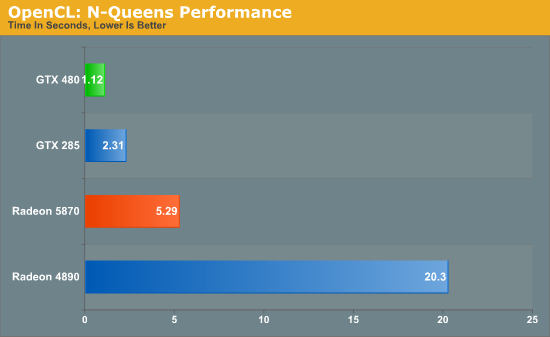
This benchmark offers a distinct advantage to NVIDIA GPUs, with the GTX cards not only beating their AMD counterparts, but the GTX 285 also beating the Radeon 5870. Due to the significant underlying differences of AMD and NVIDIA’s shaders, even with a common API like OpenCL the nature of the algorithm still plays a big part in the performance of the resulting code, so that may be what we’re seeing here. In any case, the GTX 480 is the fastest of the GPUs by far, beating out the GTX 285 by over half the time, and coming in nearly 5 times faster than the Radeon 5870.
Our second OpenCL benchmark is a post-processing benchmark from the GPU Caps Viewer utility. Here a torus is drawn using OpenGL, and then an OpenCL shader is used to apply post-processing to the image. Here we measure the framerate of the process.
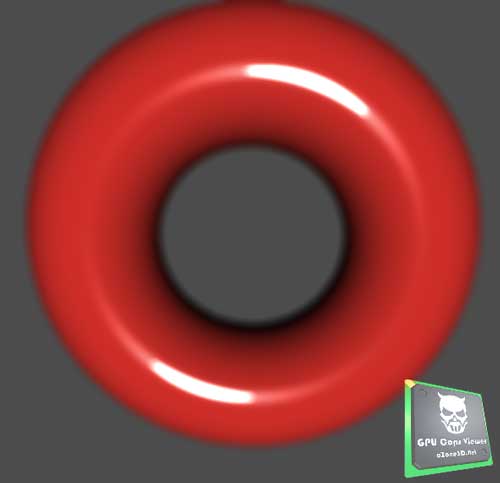
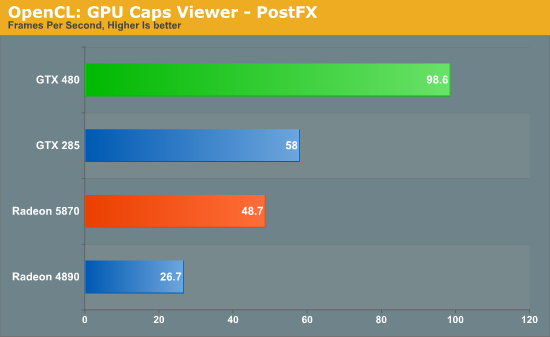
Once again the NVIDIA cards do exceptionally well here. The GTX 480 is the clear winner, while even the GTX 285 beats out both Radeon cards. This could once again be the nature of the algorithm, or it could be that the GeForce cards really are that much better at OpenCL processing. These results are going to be worth keeping in mind as real OpenCL applications eventually start arriving.
Moving on from cross-GPU benchmarks, we turn our attention to CUDA benchmarks. Better established than OpenCL, CUDA has several real GPGPU applications, with the limit being that we can’t bring the Radeons in to the fold here. So we can see how much faster the GTX 480 is over the GTX 285, but not how this compares to AMD’s cards.
We’ll start with Badaboom, Elemental Technologies’ GPU-accelerated video encoder for CUDA. Here we are encoding a 2 minute 1080i clip and measuring the framerate of the encoding process.
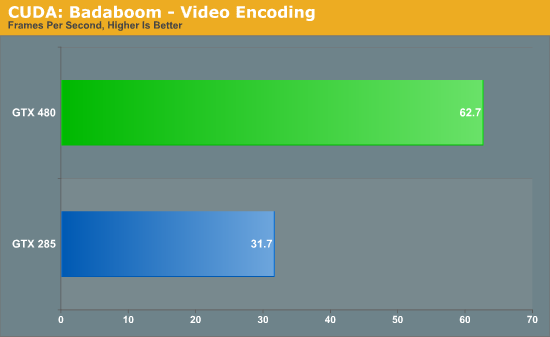
The performance difference with Badaboom is rather straightforward. We have twice the shaders running at similar clockspeeds, and as a result we get twice the performance. The GTX 480 encodes our test clip in a little over half the time it took the GTX 280.
Up next is a special benchmark version of Folding@Home that has added Fermi compatibility. Folding@Home is a Standford research project that simulates protein folding in order to better understand how misfolded proteins lead to diseases. It has been a poster child of GPGPU use, having been made available on GPUs as early as 2006 as a Close-To-Metal application for AMD’s X1K series of GPUs. Here we’re measuring the time it takes to fully process a sample work unit so that we can project how many nodes (units of work) a GPU could complete per day when running Folding@Home.

Folding@Home is the first benchmark we’ve seen that really showcases the compute potential for Fermi. Unlike everything else which has the GTX 480 running twice as fast as the GTX 285, the GTX 480 is a fewtimes faster than the GTX 285 when it comes to folding. Here a GTX 480 would get roughly 3.5x as much work done per day as a GTX 285. And while this is admittedly more of a business/science application than it is a home user application (even if it’s home users running it), it gives us a glance at what Fermi is capable when it comes to compuete.
Last, but not least for our look at compute, we have another tech demo from NVIDIA. This one is called Design Garage, and it’s a ray tracing tech demo that we first saw at CES. Ray tracing has come in to popularity as of late thanks in large part to Intel, who has been pushing the concept both as part of their CPU showcases and as part of their Larrabee project.

In turn, Design Garage is a GPU-powered ray tracing demo, which uses ray tracing to draw and illuminate a variety of cars. If you’ve never seen ray tracing before it looks quite good, but it’s also quite resource intensive. Even with a GTX 480, with the high quality rendering mode we only get a couple of frames per second.
On a competitive note, it’s interesting to see NVIDIA try to go after ray tracing since that has been Intel’s thing. Certainly they don’t want to let Intel run around unchecked in case ray tracing and Larrabee do take off, but at the same time it’s rasterization and not ray tracing that is Intel’s weak spot. At this point in time it wouldn’t necessarily be a good thing for NVIDIA if ray tracing suddenly took off.
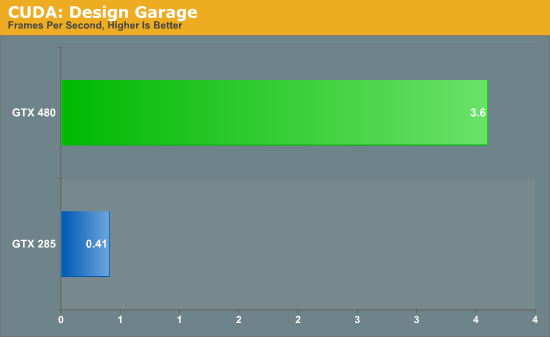
Much like the Folding@Home demo, this is one of the best compute demos for Fermi. Compared to our GTX 285, the GTX 480 is eight times faster at the task. A lot of this comes down to Fermi’s redesigned cache, as ray tracing as a high rate of cache hits which help to avoid hitting up the GPU’s main memory any more than necessary. Programs that benefit from Fermi’s optimizations to cache, concurrency, and fast task switching apparently stand to gain the most in the move from GT200 to Fermi.










196 Comments
View All Comments
ReaM - Saturday, March 27, 2010 - link
I don't agree with final words.480 is crap. Already being expensive it adds huge power consumption factor only to have a slightly better performance.
However (!), I see a potential for future chips and I can't wait for a firmy Quadro to hit the market :)
Patrick Wolf - Saturday, March 27, 2010 - link
6 months and we get a couple of harvested, power-sucking heaters? Performance king, barely, but for what cost. Cards not even available yet. This is a fail.This puts ATI in a very good place to release a refresh or revisions and snatch away the performance crown.
dingetje - Saturday, March 27, 2010 - link
exactly my thoughtsand imo the reviewers are going way to easy on nvidia over this fail product (except maybe hardocp)
cjb110 - Saturday, March 27, 2010 - link
You mention that both of these are cut-down GF100's, but you've not done any extrapolation of what the performance of a full GF100 card would be?We do expect a full GF100 gaming orientated card, and probly before the end of the year, don't we?
Is that going to be 1-9% quicker or 10%+?
Ryan Smith - Saturday, March 27, 2010 - link
It's hard to say since we can't control every variable independent of each other. A full GF100 will have more shading, texturing, and geo power than the GTX 480, but it won't have any more ROP/L2/Memory.This is going to heavily depend on what the biggest bottleneck is, possibly on a per-game basis.
SlyNine - Saturday, March 27, 2010 - link
Yea and I had to return 2 8800GT's from being burnt up. I will not buy a really hot running card again.poohbear - Saturday, March 27, 2010 - link
Oh how the mighty have fallen.:( i remember the days of the 8800gt when nvidia did a hard launch, released a cheap & excellent performing card for the masses. W/ the fermi release u would never know its the same company. Such a disappointment.descendency - Saturday, March 27, 2010 - link
I think the MSRP is lower than $300 for the 5850 (259) and lower than $400 for the 5870 (379). Just thought that was worth sharing.I have to believe that the demand will shift back evenly now and price drops for the AMD cards can ensue (if nothing else, the cards should go to the MSRP values because competition is finally out). I would imagine the price gap between the GTX480 and the AMD 5870 could be as much as $150 dollars when all is said and done. Maybe $200 dollars initially as this kind of release almost always is followed by a paper launch (major delays and problems before launch = supply issues).
AnnonymousCoward - Saturday, March 27, 2010 - link
...for two reasons: power and die size.So the 5870 and 470 appear to be priced similarly, while the 5870 beats it in virtually every game and uses 47W less at load! That is a TON of additional on-die power (like 30-40A?).
We saw this coming last year when Fermi was announced. Now AMD is better positioned than ever.
IVIauricius - Saturday, March 27, 2010 - link
I see why XFX started making ATI cards a few years ago with the 4000 series. Once again nVidia has made a giant chip that requires a high price tag to offset the price of manufacturing and material. The same thing happened a few years ago with the nVidia GTX200 cards and the ATI 4000 cards. XFX realized that they weren't making as much money as they'd like with GTX200 cards and started producing more profitable ATI 4000 cards.I bought a 5870 a couple months ago for $379 at newegg with a promotion code. I plan on selling it not to upgrade, but to downgrade. A $400 card doesn't appeal to me anymore when, like many posters have mentioned, most games don't take advantage of the amazing performance these cards offer us. I only play games like MW2, Borderlands, Dirt 2, and Bioshock 2 at 1920x1080 so a 4870 should suffice my needs for another year. Maybe then I'll buy a 5850 for ~$180.
First post, hope I didn't sound too much like a newbie.
-Mauro